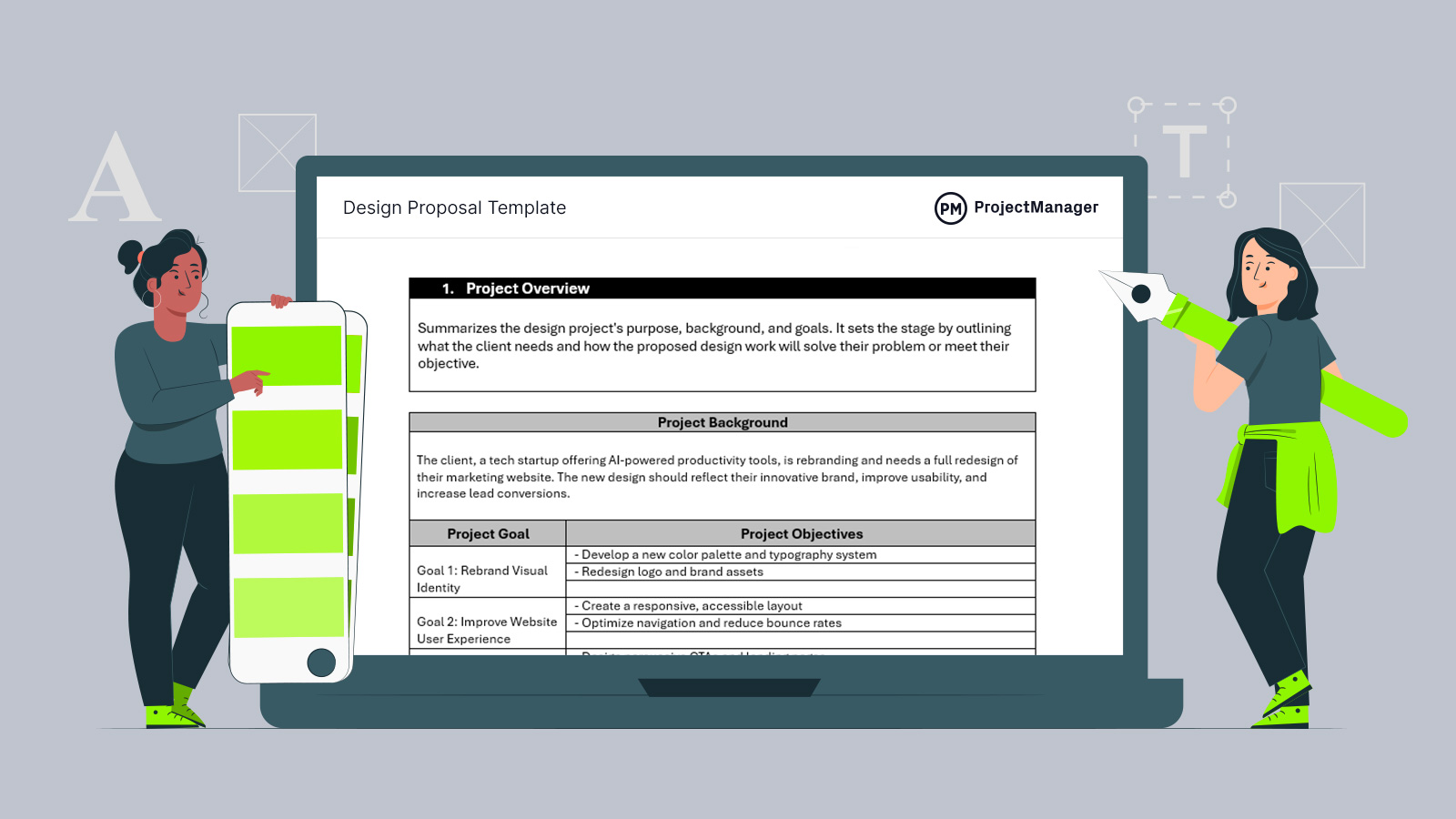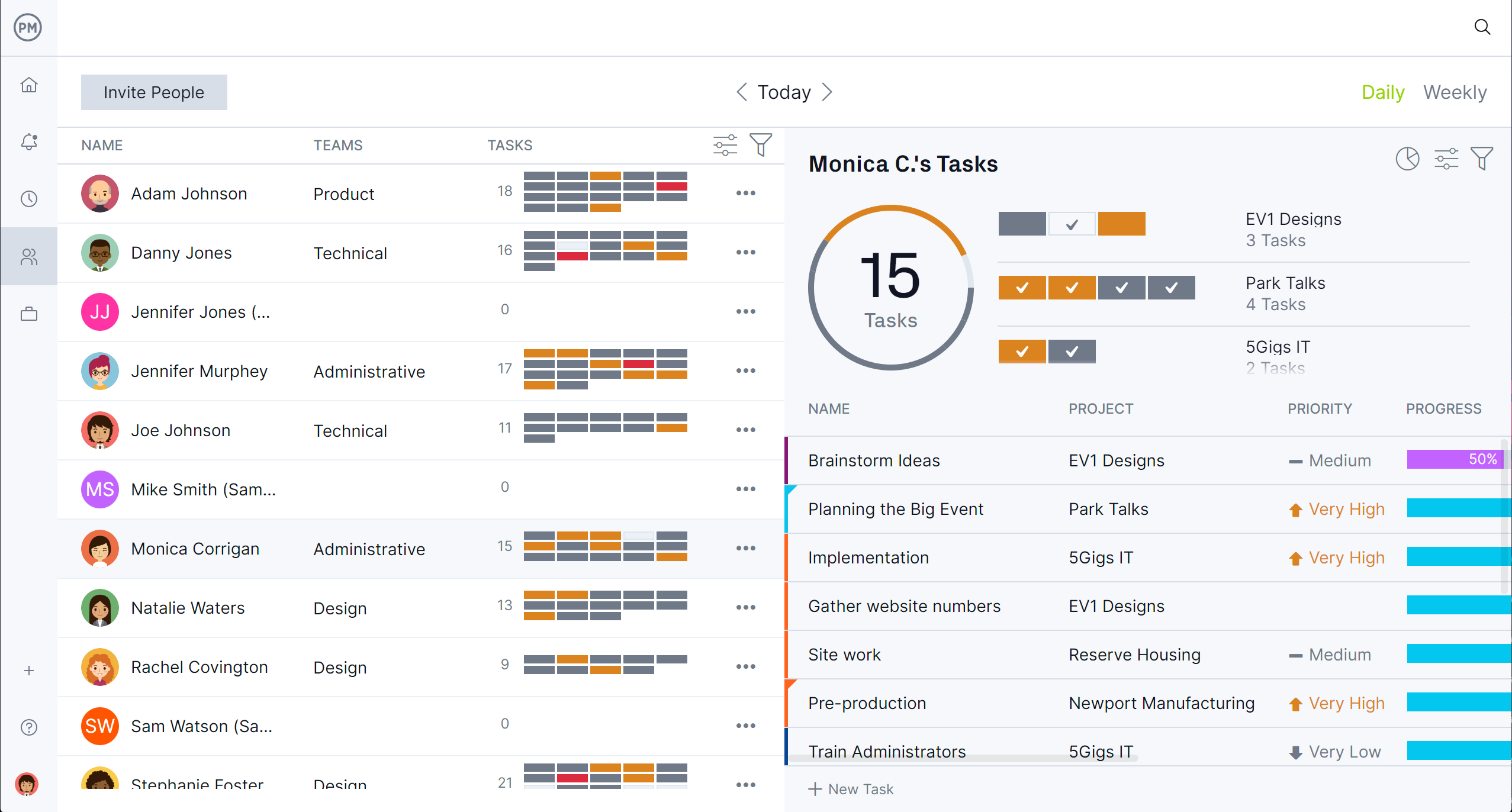A well-crafted design proposal is essential for creative teams looking to win new business. Download this free design proposal template to present your design thinking in a structured way, communicate your value clearly and set expectations with prospective clients. Whether you’re redesigning a website, branding a startup, or crafting a UI/UX experience, a professional proposal builds trust and aligns all stakeholders from the start.
Using a design proposal template for Word makes this process faster and more consistent. It ensures no key sections are missed, while also saving time for recurring project types. With a reusable format, your team can shift focus from documentation to design execution—without compromising clarity or professionalism.

Why Use a Design Proposal Template
Creating custom proposals for every new client can slow down your team and introduce inconsistencies. A structured design proposal template offers a repeatable way to present your value clearly and professionally. It helps your team communicate the project’s purpose, define its scope and align on goals—all while keeping clients informed and confident.
This template brings coherence to complex design efforts, ensuring that expectations, deliverables and timelines are transparent from day one. It also helps identify constraints early, giving you the ability to manage revisions and stakeholder input more smoothly. Ultimately, using a proposal template promotes clarity, accountability, and better collaboration across creative and client teams.
A design proposal template provides the foundational scope, objectives, deliverables and timeline estimates for a design project, which directly informs the creation of a Gantt chart. By outlining key phases—such as research, concept development, revisions, approvals and final delivery—the proposal acts as a blueprint for defining tasks and milestones. These elements are translated into individual bars and dependencies on a Gantt chart, allowing teams to visualize the project’s sequence and flow.
Not all Gantt charts are the same. ProjectManager is award-winning project and portfolio management software that has robust Gantt charts to turn a design proposal into an actionable plan. Schedule tasks, resources and costs, then link all task dependencies to avoid cost overruns when executing the job. Project managers can filter for the critical path and set a baseline to track progress in real time. Get started with ProjectManager today for free.

When To Use This Design Proposal Template
Use this design proposal template whenever you’re presenting a design solution for approval before starting work. It’s ideal for pitching ideas, securing buy-in, and aligning expectations. Common use cases include freelance designers proposing new branding, agencies bidding on creative projects or architecture firms outlining building concepts.
It helps you organize the scope, timeline and budget clearly, whether you’re offering digital, physical, or visual design services. This template is especially useful during the early planning stages, before contracts are signed or resources are committed. Use it to make a professional impression and streamline communication with clients or stakeholders.
Who Should Use This Design Proposal Template
This template is for anyone offering professional design services and needing client approval before beginning a project. It’s especially helpful for individuals and teams who must clearly present their vision, deliverables and pricing in a structured, persuasive format.
- Freelance Graphic Designers: Use it to propose branding, logos or print materials to clients, setting clear expectations for deliverables, cost and timeline.
- UX/UI Designers: Present website or app designs, wireframes and workflows to clients or product teams for early-stage feedback and alignment.
- Architects: Share conceptual drawings, material choices and technical details with clients or regulatory boards before detailed planning begins.
- Interior Designers: Pitch room layouts, themes and finishes to clients while clarifying the project scope, budget and estimated delivery schedule.
How to Use this Design Proposal Template for Word
This design proposal template is built to simplify and professionalize your project pitches. Whether you’re freelancing or part of a creative agency, it walks you through the essential elements needed to define, scope, and price your design work. Follow these steps to complete the template efficiently and tailor it to each client’s unique needs.
1. Define Goals and Objectives for the Design Project
Begin by clearly outlining the goals and objectives of the project. Goals represent the high-level outcomes your client is seeking—such as increasing user engagement or modernizing a brand. Objectives, on the other hand, are the actionable steps needed to meet those goals, like developing a new color palette or improving mobile navigation. Writing these down first ensures every aspect of your proposal stays aligned with client expectations.
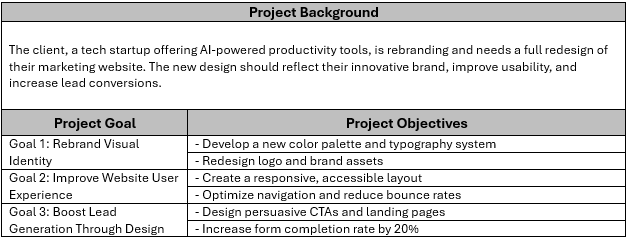
2. Describe the Scope of Work
Next, define the scope of the design project. This includes summarizing what tasks will be performed, when, and by whom. Use the template’s built-in structure to clarify deliverables, timelines, dependencies and what’s not included. This step helps prevent scope creep, builds client confidence and ensures both parties agree on what success looks like. Don’t forget to fill in key project milestones and note any assumptions or constraints that could impact delivery.

3. Establish a Timeline for the Design Project
This template includes an embedded Gantt chart to help you visualize the project timeline from start to finish. Use it to lay out all major phases, task durations, dependencies and key milestones. This visual roadmap helps clients understand the sequence of work and expected delivery dates, making it easier to coordinate feedback and approvals. A clear timeline also helps your team manage workloads and stay on track across multiple active projects.
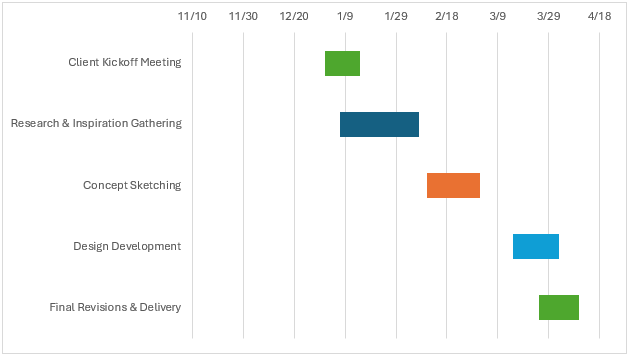
4. Explain the Steps of the Design Process
Now it’s time to walk the client through your design methodology. This section of the template helps you map out each phase of the process—from discovery to final delivery. Reference the tools and touchpoints you’ll use, such as research sessions, mockups and revisions, while noting where client input is expected. Clearly outlining your workflow adds professionalism and sets expectations, making collaboration more efficient and helping clients feel confident in your approach.
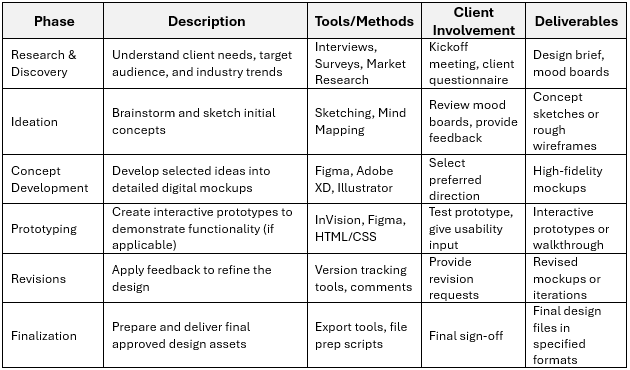
5. Fill Out the Cost Breakdown
Use this section to itemize the financial aspects of the project. The template provides space to break down labor costs by role and task and to list any additional resources such as software, image licenses or testing tools. You can specify whether you’re charging hourly, by milestone or with a flat rate. This level of transparency not only builds trust but also helps avoid pricing misunderstandings later in the engagement.
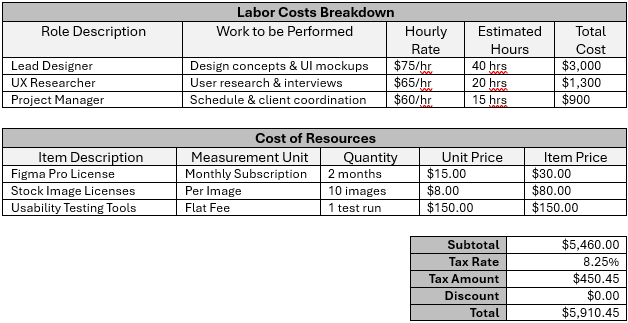
6. Define the Payment Terms
Once costs are detailed, clarify how and when payments should be made. This part of the template helps you set expectations around deposits, milestone payments and the final balance. You can also note accepted payment methods, due dates and any applicable late fees. Outlining these terms upfront ensures mutual accountability and reduces the risk of delays or disputes during the project.
7. Clarify Client Responsibilities
The final step is to specify what the client is responsible for providing. This may include timely feedback, content, logos or access to key stakeholders. Clearly defining these responsibilities ensures that both parties stay aligned, helps the project move forward without unnecessary delays and reinforces a collaborative working relationship throughout the design process.
Related Project Management Templates
A design proposal template is only one of over 100 free project management templates for Excel and Word that can be instantly downloaded from our site. These templates cover all aspects of managing a project. Here are a few that can be used with a design proposal.
Creative Brief Template
Download this free creative brief template to outline key information about a creative project before it begins. It serves as a communication tool between stakeholders, such as clients, marketing teams and creative professionals, to ensure everyone understands the project goals, audience, messaging, tone and deliverables.
RACI Matrix Template
Use this free RACI matrix template to help define and clarify team roles and responsibilities for specific tasks or deliverables. The acronym RACI stands for: responsible (the person(s) who does the work to complete the task), accountable (the person who is ultimately answerable for the task’s success), consulted (individuals or groups who must be consulted before a decision or action is taken) and informed (those who need to be kept informed of progress or decisions but are not directly involved).
Service Proposal Template
This free service proposal template outlines the services a business or professional intends to provide to a client, along with relevant details such as objectives, scope, deliverables, timelines, pricing and terms. It serves as both a sales tool and a foundational agreement, helping service providers clearly communicate what they offer and how they plan to meet the client’s needs.
How to Manage Design Projects With ProjectManager
Managing design projects with ProjectManager provides creative teams with the flexibility and control they need to stay on schedule and deliver high-quality work. The software offers multiple project views—including Gantt chart, kanban board, sheet, list and calendar views—so teams can choose the visual format that best suits their workflow. Unlike with templates, creative leads might use the Gantt chart to map project timelines and dependencies, while designers may prefer kanban boards for managing tasks in a more visual, drag-and-drop format. This adaptability makes it easy to align project planning with how each team member works best.
Use Resource Management to Manage Multiple Projects or Clients
ProjectManager also includes robust resource management tools that are especially useful for design teams juggling multiple projects or clients. The team page gives managers a clear overview of who’s assigned to what, while the availability tools prevent overloading specific team members. The workload chart visualizes how tasks are distributed, making it easy to reassign or balance work in real time. These features ensure optimal use of creative resources and help prevent burnout, a common risk in fast-paced design environments.

Ensure Projects Stay on Track With Real-Time Dashboards and Reports
To ensure projects stay on track, ProjectManager offers a suite of tracking features, including real-time dashboards that provide instant insight into project performance, timelines and budgets. Customizable reports let you generate status updates tailored to stakeholders, while secure timesheets track hours spent on design tasks for better cost management and billing accuracy. Together, these tools give design project managers the oversight needed to adjust quickly, manage client expectations and deliver successful creative outcomes on time and within scope.
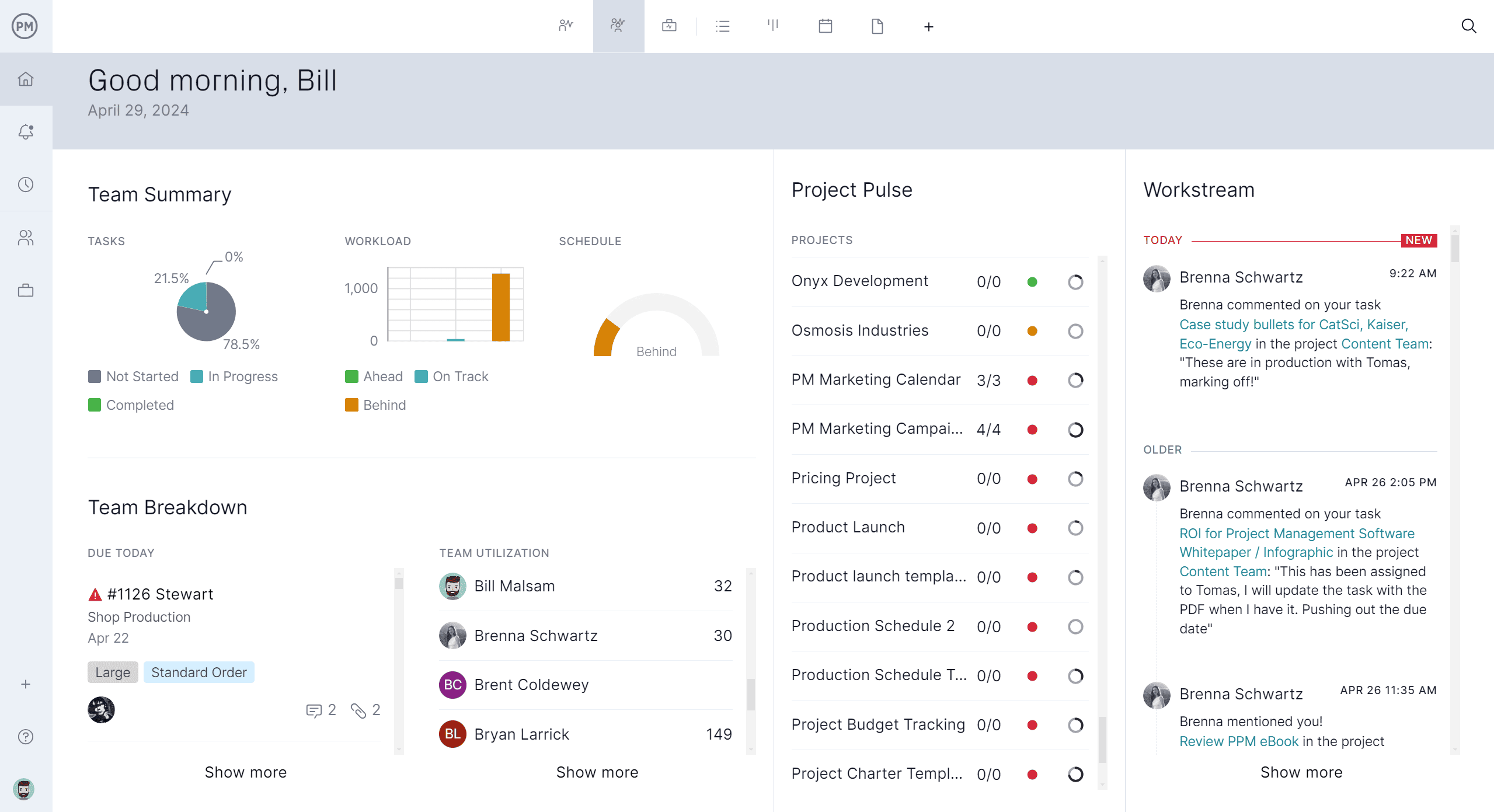
Related Project Management Content
A design proposal template is a part of the larger project management process. For readers who are interested in learning more about this topic, follow the links below. They lead to recent articles on how to write a creative brief and other related piece.
- How to Write a Creative Brief (Example & Template Included)
- Design Brief: A Quick Guide
- Creative Project Manager: Role, Responsibilities & Skills
ProjectManager is online project and portfolio management software that connects teams whether they’re in the office or out in the field. They can share files, comment at the task level and stay up to date with email and in-app notifications. Join teams at Avis, Nestle and Siemens who use our software to deliver successful projects. Get started with ProjectManager today for free.
